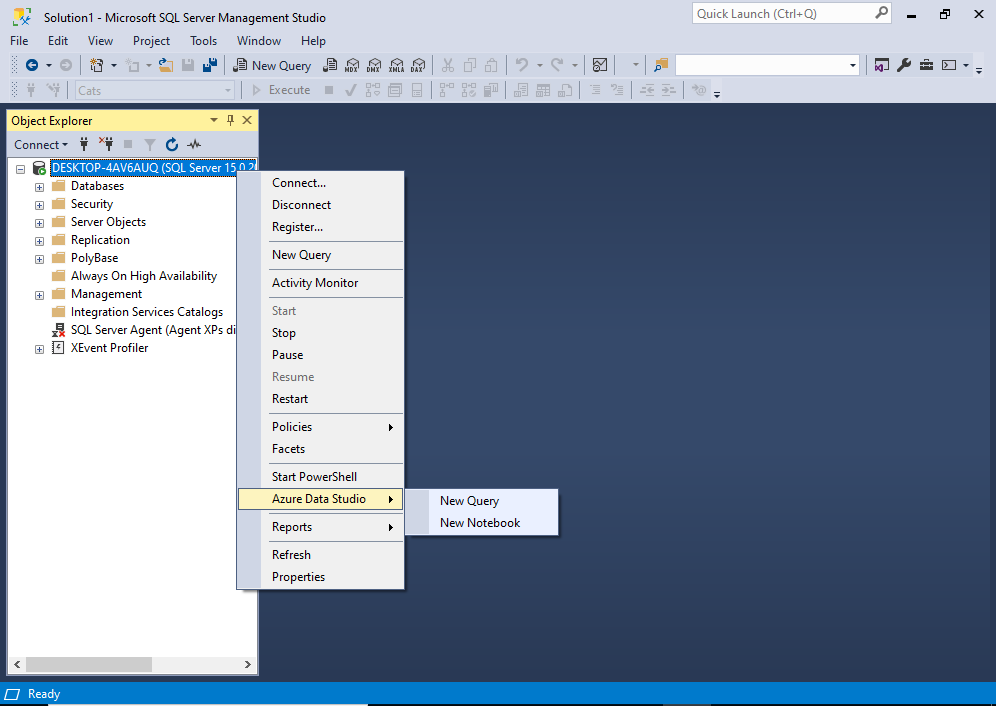

- MICROSOFT AZURE DATA STUDIO INSTALL
- MICROSOFT AZURE DATA STUDIO FULL
- MICROSOFT AZURE DATA STUDIO OFFLINE
- MICROSOFT AZURE DATA STUDIO WINDOWS
full and t-log) into a single backup media is not supported. However, appending multiple backups (i.e. Each backup can be written to either a separate backup file or multiple backup files.You need to take backups using the WITH CHECKSUM option.Azure Database Migration Service does not initiate any backups, and instead uses existing backups, which you may already have as part of your disaster recovery plan, for the migration.Make sure to create the Azure Storage Account in the same region as the Azure Database Migration Service instance is created. If your database backup files are provided in an SMB network share, Create an Azure storage account that allows the DMS service to upload the database backup files.Restore backups on target Azure SQL: DMS restores backup files from your Azure Storage account to the supported target Azure SQL. Data movement activities and pipelines are automatically created in the migration workflow to upload the backup files. DMS provides the authentication keys and registers the self-hosted IR.īackup files upload to Azure Storage: DMS uses self-hosted IR to upload valid backup files from the on-premises backup location to your Azure Storage account. Self-hosted integration runtime (IR): Self-hosted IR should be installed on a machine that can connect to the source SQL Server and the location of the backup file. DMS is associated with Azure Data Factory's (ADF) self-hosted integration runtime (IR) and provides the capability to register and monitor the self-hosted IR.
MICROSOFT AZURE DATA STUDIO INSTALL
Azure Storage blob containers and Azure Storage file share are also supported.Īzure Data Studio: Download and install the Azure SQL migration extension in Azure Data Studio.Īzure DMS: Azure service that orchestrates migration pipelines to do data movement activities from on-premises to Azure. Network File Share: Server Message Block (SMB) network file share where backup files are stored for the database(s) to be migrated. Target Azure SQL: Supported Azure SQL targets are Azure SQL Managed Instance, SQL Server on Azure Virtual Machines ( registered with SQL IaaS extension - full management mode), or Azure SQL Database (Preview). All versions of SQL Server 2008 and above are supported. Source SQL Server: SQL Server instance on-premises, private cloud, or any public cloud virtual machine. The workflow of the migration process is illustrated below. DMS provides a reliable migration orchestrator to enable database migrations to Azure SQL.Ĭreate or reuse an existing DMS using the Azure SQL migration extension in Azure Data Studio (ADS).ĭMS uses Azure Data Factory's self-hosted integration runtime to access and upload valid backup files from your on-premises network share or your Azure Storage account. Architecture of Azure SQL migration extension for Azure Data StudioĪzure Database Migration Service (DMS) is one of the core components in the overall architecture. Including the new workflow for SQL Server database assessments and SKU recommendations. The following 16-minute video explains recent updates and features added to the Azure SQL migration extension in Azure Data Studio. You can use tools as SQL Server dacpac extension or, SQL Database Projects extension for Azure Data Studio. If your target is Azure SQL Database (Preview), make sure to deploy the database schema before starting the migration. SQL Server to Azure SQL Database (Preview) SQL Server to SQL Server on Azure Virtual Machine The flexibility to create and configure a self-hosted integration runtime to provide your own compute for accessing the source SQL Server and backups in your on-premises environment.Ĭheck the following step-by-step tutorials for more information about each specific migration scenario by Azure SQL target: Migration scenario.
MICROSOFT AZURE DATA STUDIO OFFLINE

MICROSOFT AZURE DATA STUDIO WINDOWS
You can assess SQL Server databases running on Windows and Linux Operating systems using the Azure SQL migration extension.


 0 kommentar(er)
0 kommentar(er)
